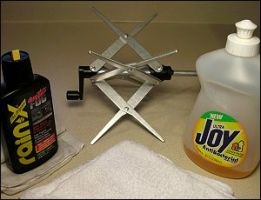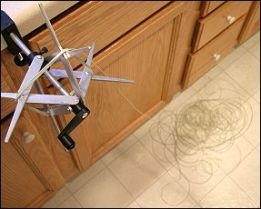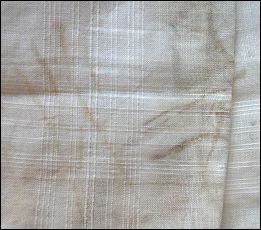Maintaining that expensive string coated with plastics and polymers is the best medicine for adding years of life your flyline. Consider cleaning flylines after every 3-5 uses or when the water is particularly dirty.
Routinely Maintaning Flylines Can Add a Few Extra Years of Useful Life
3 Steps to Fresh Lines
It pays to clean your flyline after every 3-5 usages or when you've fished particularly muddy, dirty, weedy or mossy water. I just had to retire a flyline I purchased in 1997 and have used consistently for much of my flyfishing over the years. I estimate the line has seen over 150 outings. But I wouldn't have had such good luck with the line had I not taken care of it.
How To Tell if a Flyine Requires Cleaning
It's not too difficult to tell if your line needs cleaning, look for these clues:
- You feel micro-grit on the line as you strip it in
- For floating line, the first 10 feet or few meters of line doesn't float any longer
- The line retains coil memory
- The line has small cracks
- The line feels brittle
If the latter two observations above are noticed, the bad news is that the line is on its last legs of life. The good news is a cleaning and re-invigoration of the line may add another season of use before you have to replace the line.
Cleaning a Fly Line

Materials are simple and your workspace can be as simple as the kitchen sink.
Materials
The materials are simple:
- Mild dish soap
- Clean rag
- Flyline dressing (discussion on this topic below)
- Line winder (optional)

Cleaning a flyline only takes about 1/2 hour of your time. It's time well invested in preparation for your next few flyfishing trips.
STEP 1 - Soaking
- Draw about a gallon or a few liters of hot water in a sink
- Add just a few drops of mild dish soap. Don't overdo it! All you need is enough to make a few bubbles and help loosen debris. Too much soap will leave a film on the flyline which may help it sink. (not good for floating lines!)
- Strip out all the flyline IN LOOSE coils in the sink, ensuring each coil lies on top of the previous. This will help prevent the line from knotting up as it is cleaned in the next step
- Allow the line to soak until the water becomes luke-warm; about 15-30 minutes or so.

Stretching the line is an important step in cleaning it. Stretching the line once-in-awhile helps maintain its suppleness and prevent line coil memory.
STEP 2 - Cleaning
- Taking a clean, moistened rag in one hand, draw the flyline from the sink through
the rag - Apply mild pressure with the hand holding the rag to ensure the line is being "stripped" of all the debris and dirt
- You'll know if you have enough pressure by hearing the line "sqweek" through your hands
- LOOSELY coil the line on the floor at your feet in preparation for dressing the line with conditioner and allowing the line to dry for a few moments
- TIP: as you draw line through the rag, stretch each arm's-length section as you would a leader, to stratighten out the coils that have built up.

Loose coils of line prevent knotting and tangling.
STEP 3 - Dressing
- Using a line winder, if you have one, makes applying line conditioner easier, but is not necessary.
- Taking another dedicated rag used for applying line conditioner, soak the rag with conditioner
- As the line is wound on the winder, apply the line conditioner in the same manner as the line is cleaned in the step above.
- Don't be afraid to be generous with the line conditioner; it's the stuff that will help protect the line in future uses.

Just like a good teeth flossing, flyline cleaning cleans up the dirt you can't see!
Dirt Be Gone!
One flyline can hold a lot of dirt as shown on the rag I used to clean the flyline in this example!

Many commercial products on the market are excellent choices for dressing your flyline once it is cleaned.
Fly Line Dressings
Many different manufacturers produce and sell flyline dressings. So, don't be afraid to try any one of them. But I have found over the years a particular product, not even designed for the flyfishing industry, works quite well in cleaning and dressing flylines.
I like to use Rain-X windshield dressing. It is safe for plastics, as it clearly says on the bottle. Rain-X does a bang-up job of repelling water on windshields for months on end, so why wouldn't it work on flylines!?
I have used Rain-X since 1996. Never had I had a flyline become brittle or "melt-away" as some flyfishers may warn you of. I'm a believer in its use.
There may be other products on the market that work just as well. Just one word of caution: be sure the product is safe for plastics. If it doesn't say that, don't even venture in trying it on flylines. Products that are silicon-based are your best bet. Silicon is flyline-friendly. Flylines are delicate, expensive strips of plastics and polymers that won't tolerate chemicals which can break down the coating, be careful in choosing alternate line dressings not intended for flylines.
- Log in to post comments








Checked with my loca
Checked with my local pro after reviewing the shelf offerings at Canadian Tire. He confirmed what I'd read, that both Rain-X Interior and Exterior formulations were proscribed for use with plastics. He said they worked at one time with old technology
(rubber and other organics) but not with latter day compounds. There is a Simoniz product specifically designed to restore plastics and I was momentarily intrigued by it; it's the one used to wipe down headlight lenses and make 'em sparkle again. But I went with Scientific Anglers Fly Line Dressing anyway.
Rain-X Anti-Fog inte
Rain-X Anti-Fog interior-use compound directions quoted saying,"Do not use on plastics unless pre-approved by the manufacturer ..." Is this the de-mister referred to above? Advice against use on fly lines kinda converges here. I'll check further on directions/instructions for the external use Rain-X and report back on whether safe for plastics.
Jeff, You can use
Jeff,
You can use silicone spray, Amorall or plastic conditioners of all sorts as long as you are careful that they don't harm the line. Some of the solvents in these conditioners may have unwanted effects on the coating of your fly line like softening or simply dissolving the surface.
Try it out on a small piece of line before you embark on a full treatment. Most fly line manufacturers warn against using any odd treatment and of course endorse their own brand name solution.
If in doubt use soap, water and a cloth and nothing else. You'd be surpirsed how big a difference it makes.
Martin
Why not just use pla
Why not just use plain old silicone spray...
I've been using it for years on my wifes rubber hip boots...
It has prevented any dry root or cracking.
We bought them in 1982....She still wears them today.
Just got back from a
Just got back from an Atlantic Salmon fishing trip and the guide said he has used Armour all for years and swears by it. I was a bit skeptical as I have heard that it has had adverse effects on car dash boards. seems it works for some though.
I ordered ZipCast ab
I ordered ZipCast about 4 weeks ago with my credit card. The card hasn't been charged yet and I haven't recieved the purchase. Is ZipCast still in business?
Thanks
M. Jørgensen,
M. Jørgensen,
I did not mean to offend you!
But I was just surprised by the conclusion, because changing density would mean that weight had to be taken away or added while the volume staid the same... not a likely scenario. The net result is that the sinking or intermediate line can sometimes float after a treatment, and that you have to be aware of that.
Martin
It seems like i have
It seems like i have been using a wrong wording - my deepest apologise for that. It shall not happen again
M. Jorgensen,
I w
M. Jorgensen,
I would be surprised if the dressing changes the density of the line.
It's more likely that the dressing forms a water repellent layer, which makes the line float. You can get the same effect using Mucelin or an other type of floatant on the line.
Martin
I have tried several
I have tried several brands for cleaning and dressing the lines - whitout being impressed - almost giving up 3 years ago I tried Scientific Anglers "Fly line Dressing" with really impressive results. Just - dont use it on intermediate or sinking lines - as it has a severe impact on the density. (I haven't tried any of the other products mentioned here so this comment does not represent a a comparison to the mentioned brands).
I tried Armor All wi
I tried Armor All wipes to clean 3 flylines for the first time today because I couldn't be bothered a) waiting for propietary fly line cleaner to arrive in the mail b) paying the $7-$10 - not including postage- that it costs to get it. I have to say the Armor all certainly did a good job of getting the muck off and the line felt a lot slicker once I was done. The true test will be to see how it fishes...For those who are concerned about damage to the line etc, my gut feeling is that by the time you've finished the residual amount on the line is probably so small that it most likely won't hurt anything. Could always be proven wrong, however....
Duh Uh! If Rain X is
Duh Uh! If Rain X is not for use on plastic then why does it come in a plastic Bottle and how can a Plastic Zip Lock bag survive the storing of Rain X Wipes???
"All is as it should be in the Universe"
I have also had armo
I have also had armor all crack my dashboards and have had heard it happen to many people as well. Probably would do the same to a fly line, so I don't think i'm going to use it.
A caution about Armo
A caution about Armor-All. I have found that, while it's designed for use on vinyls and other plastics, it can degrade them down over time with UV exposure. I have a couple of Porsche dash replacements to confirm my suspicions, and a Brother who, being an engineer who specialized in plastics manufacture, doesn't like Armor-All on plastics long-term either. I know it's made for them, but it seems to actually dry out interior parts in the sun. Perhaps just my experience, but it is my experience, nonetheless. I've had really good luck with 303 Protectant, though I have never used it on fly lines. Vinylex is also really good for car plastics.
All that said, I'm enclined to echo the sentiment to use products designed for the lines. They may be precisely the same formulation as something like 303, but they are relatively cheap and I don't use them every day, so they last a while. Now, if I find that, say, SA cleaner is really the same chemical cocktail as my gallon of 303, the choice is easier. And I will be sure to let everyone know!
Another product that
Another product that works very well for dressing your flyline is armor-all. It is safe for plastics and has uv protection which is important for flyline. Try it
lets be sure whateve
lets be sure whatever line treatment we use is safe for the environment and water as well as plastics!
Rain-X?
Look at the
Rain-X?
Look at the bottle - black with yellow printing. This is Rain-X demister, not Rain-X outside windscreen treatment. A different animal!
Les
My Rain-x bottle has
My Rain-x bottle has a warning on the back that says, "Do not use on plastics."
This contradicts what Steve Schweitzer says about using this product for dressing fly lines and that it is safe. Are there different types of Rain-x with different chemical make-ups? Mine is a clear liquid of water-like consistency.
Using one of the alt
Using one of the alternative conditioners shouldnt cause any problems as long as u look what's in the bottle. Most of the stuff they sell in fly stores are probably stuff like Rain-X or other cleaners that has been on the market for many years for alternative use and then refilled into small bottles and overcharged 5 times because it is sold for fly fishing purposes. Most silicone based cleaners will work well anyway so why pay sick overprizes for 10 mL when u can buy 1 L for the same amount? Then u can be a tad more gentle with the amount u apply.
I use what the manuf
I use what the manufacturer recommends. Period. The people who made it know what is best. My lines last for a long time. What are you trying to prove using something else? Is it cheaper? Better, how? As most lines are in the $55-60 range why would you use something like Rain-X? Take the time and do it right.
Baby oil also good.
Baby oil also good.
thanks for verifying
thanks for verifying the use of Rain-X for flylines. Do you know if it can be used with monofilament? Thank you.
ZipCast cleans, lube
ZipCast cleans, lubes and protects the line in just one pass. Makes line maintenance much easier. Found out about it on this site's review and ordered a bottle. Amazing stuff. Best I've ever used.
Rain-X also comes in
Rain-X also comes in wipes that can be used over and over if stored in a container or zip-lock baggie.
GREAT WEB SITE.
Fly Line Conditioner
I've been fly fishing, making custom cane fly rods, furling and varnishing my own silk lines and leaders for nearly fifty years now.
I can remember when you could buy a good Pflueger Medalist out of the Sears and Robuck for a hefty price tag of $9.00 and the only fly line you could even buy then was woven, level floating and you usually had to strip it and re-varnish it once a year or when it started to show cracks. I've seen the era of bamboo come and go and come back again. Then I seen fiberglass hit the market for a short window, till graphite and composites came along followed by all kinds of fancy new technologically super plastic polymer advanced fly lines, and I'm still using the same conditioner on them as I have used on every other fly line I have had over the course of half a century. Natural deer tallow from under a deer's tail. Buck or doe, don't matter, and if you hunt, it's free and in abundance.
Fall deer is better of course because they are building up stores for the cold winter. Completely waterproof, natural conditioner and it lasts forever. Does not build up a sticky film. Fly's through your guides like shit through a goose. Does not collect dirt. No chemicals. Won't harm plastic, poly, nylon, rubber or any other artificial or natural fiber.
So there you have it in a nut shell. A little bit of old school.
John
I agree with John
I agree with John. Old school. McDonalds used a mix of more than 90% beef tallow for thier friers. Its cery versatile stuff. From cooking to airplane fuel. Flux for soldering to leather conditioning... soaps and it was even used a gun lube in the Civil War. I used it for restoring leather jackets and baseball gloves. Never on a fly line. Im still new to fly fishing. Im probably going to swing by a sports shop and grab a tube of tallow based conditioner. It works on synthetic gloves and is safe for plastics as most gloves has a polymer logo sewn to it.